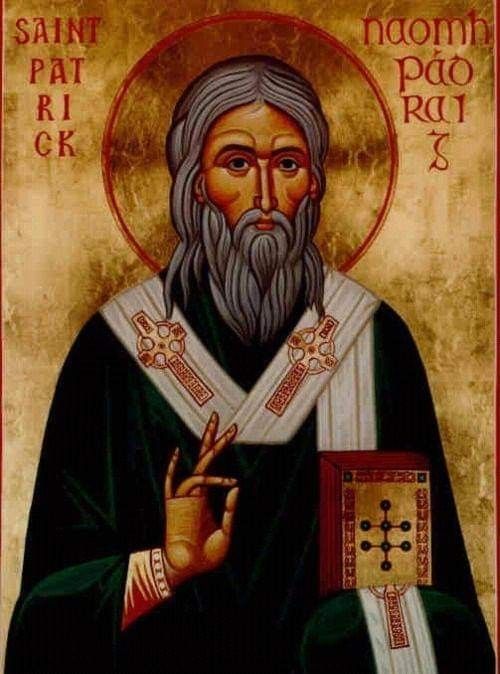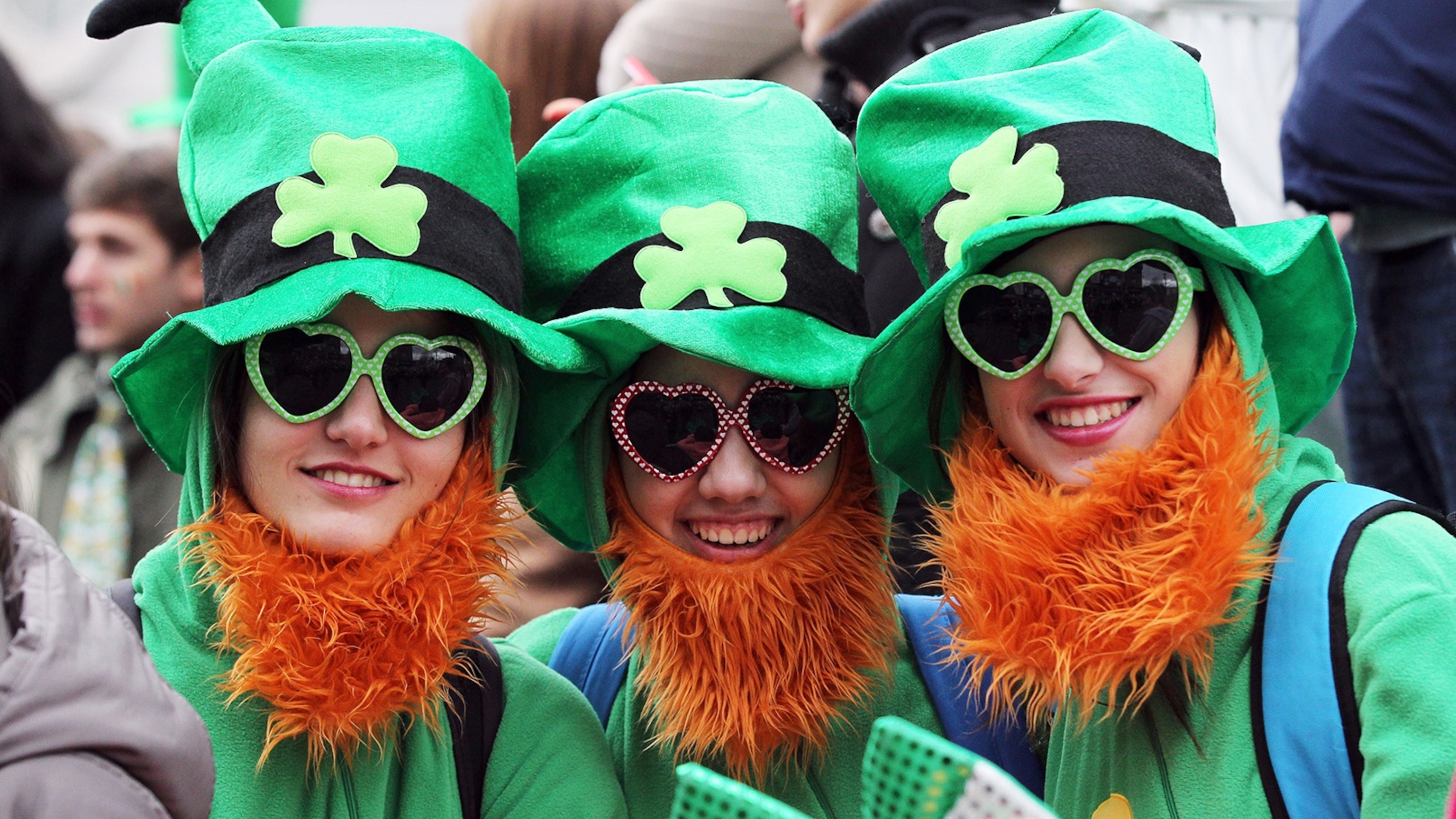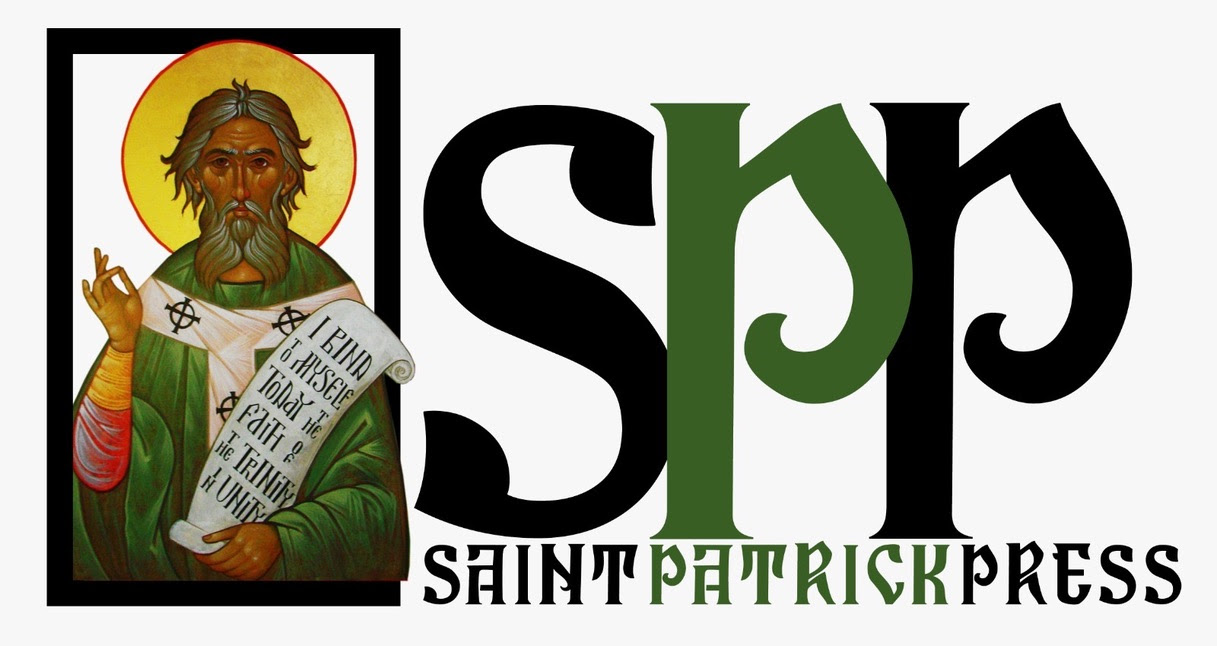St. Patrick’s life is juxtaposed against the hedonism of the popular Guinness suffused St Patrick’s Day. Indeed St. Patrick was a humble monk and ascetic.
He who dwells in the secret place of the Most High Shall abide under the shadow of the Almighty. I will say of the LORD, “He is my refuge and my fortress; My God, in Him I will trust.”
Psalm 91: 1-3

The pop-icon and the saint

St. Patrick is a wonderful, very real saint. I have seen him show up in my own life and in lives of my friends–he is really beautiful.
However, the popular cultural expression of ’St. Patrick’s Day’ indeed overshadows his life of holiness.
To highlight what I’m talking about, here are some ‘fun facts’ about St. Patrick’s Day …
- Blue, Not Green: The official colour of St. Patrick’s Day is actually blue, given that it is the colour of the coat of arms made by King Henry VIII when he made himself king of Ireland. This was also recounted to me by a colleague who grew up in Ireland. Nevertheless, St. Patrick was a monk and ascetic, so I doubt he was wearing garments of striking colour–probably wore black. More on that later.
- St. Patrick Not Originally from Ireland: Yes, St. Patrick wasn’t from Ireland–and he may not have been from Britain either. In a fascinating book entitled Rediscovering Saint Patrick by Marcus Losack, Saint Patrick is presented as possibly being from Brittany France.
- Green Chicago River: Every year the city of Chicago dumps green dye into the Chicago River. The city’s been doing that every year since 1962.
- Guiness is Tops: A lot of Guiness is drunk on St. Patrick’s Day. It is estimated that roughly 14 million pints are consumed on that day alone. One source said that in the UK alone the number of pints was 14 million.
- The Largest St. Patrick’s Day Parade: New York has run the St Patrick’s Day Parade since 1762. It is one of the largest parades in the world.
- Dollars Spent: According to Wallethub, $5.7B is the amount spent collectively on St. Patrick’s Day in 2022.
- More Drinking: The average person will consume 4.2 drinks on St Patrick’s Day
- Binge Drinking a Thing Among Men: 32% of men admit to binge drinking on St. Patrick’s Day
- A Lot of Beer: 174% more beer is sold on St. Patrick’s Day than usual
- Drunk Driving Fatalities: Over St Patrick’s Day, alcohol related car crashes claim a life every 38 minutes. And 63% of fatal St. Patrick’s Day holiday car crashes involved a drunk driver
- Eating on St. Patrick’s Day is Important to Many: 34% of Americans plan a special dinner on St. Patrick’s Day.
Who is this saint?
The eleven points above have absolutely nothing to do with Saint Patrick.
Let me explain a little about him …
When St. Patrick was a young man, his home was attacked by pirates. His parents were murdered in the attack, and St. Patrick was taken to Ireland as a kind of slave. He served as a slave for seven years, during which time he had an encounter with God and lived a life of solitude and prayer while tending sheep. Eventually he fled Ireland and returned home. While with family and friends, he had a dream in which people from Ireland were crying out to him to return and be their shepherd. He returned to Ireland where he eventually became Bishop of Ireland. During that time St. Patrick wrote his Confessions which were directed to the Roman Catholic Church seeking his excommunication based on some kind of trumped up charges of indiscretion brought forth by an old friend of his about a deed he had committed in his youth. St Patrick persisted in the work of God. He baptized countless people, and showed his love to all he encountered.
There’s some mystery surrounding St. Patrick that Marcus Lossack lays out in his books, such as why for 250 years after St. Patrick’s repose nothing was written about him. Then there are a multitude of accounts through which one needs to sift to find the difference between the man and the myth.
The ascetic life of St. Patrick
But there’s something that comes out of Marcus Lossak’s Rediscovering Saint Patrick that I find so beautiful and inspiring, namely St. Patrick’s monasticism and asceticism.
It is very likely that Saint Patrick’s mother was the cousin of St. Martin of Tours. It is also likely that Saint Patrick was tonsured a monk at St. Martin of Tours’s monastery.
Several of the ancient sources claim that St. Patrick was trained and tonsured in the community of St. Martin of Tours. The credibility of this connection is strengthened by the claim that Patrick’s mother, Conchessa, was ‘of the Franks’ and that she was St. Martin’s niece. If this is true, Martin and Patrick were closely related. The primary source for information about St. Martin is Sulpitius Severus (363-420 AD).
Rediscovering St. Patrick, 152.
In his Confessions, St. Patrick talks a bit about his life devoted to prayer and poverty. After he fled Ireland, he had a dream in which he believed the Irish people were calling him back. Later, he joined the monastery where he spent some years in ascetic practice before joining a group of barefoot hermits and lived on an island off the coast of France.
Probus records that St Patrick was trained within St Martin’s community and that he was tonsured there. It was here that St Patrick was first ordained in holy orders and learned about doctrine and the lectionary. When St Patrick left the community of St Martin, Probus records that he spent the next eight years on an island with the ‘people of God’ who are described as a community of ‘barefoot hermits’ …
Rediscovering Saint Patrick, 144.
After spending some years with another group of “solitaries”, St. Patrick received Episcopal orders by a bishop called ‘St. Senior’. St Patrick must have felt he was prepared to go to Ireland and spread the Gospel of Christ to all its inhabitants. In fact, he believed that by journeying to Ireland he was the last remnant of the Apostles taking the gospel to the ends of the earth.
St Martin of Tours and the Coptic monastic tradition
A very interesting thing about St. Martin of Tours’s monastery is that St. Martin was somehow inspired by the desert monks of the Coptic tradition who lived in the Egyptian desert–people like St. Antony. In fact, St. Martin had camel hair somehow brought to his monastery from Egypt for he and his monks to wear. They tried to carry closely the ascetic tradition of the Coptic desert tradition.
Martin embraced the teachings of (Coptic) Egyptian Desert . Spirituality, following the example of St Antony, to the extent that all members of his community wore simple garments made from camel hair which had been imported directly from Egypt. Severus shows us how important the Egyptian Desert Tradition was for them when he said, ‘As long as I live and retain my senses, I will always celebrate the monks of Egypt’.
Rediscovering Saint Patrick, 153.
An interesting thought is how was St. Martin exposed to the Coptic ascetic tradition?
The way I see it, it is likely he was visited by bilocating monks who appeared to St. Martin and shared the ancient tradition with him.
But what’s striking is St. Patrick was thus trained in the Coptic ascetic tradition also. So in spite of being thought of as very much a western saint, he was steeped in and influenced by the eastern tradition of the Copts, and lived an ascetic life much like the desert fathers of his day albeit in a completely different region of the world.
St. Patrick—a bare-foot hermit
After leaving St. Martin’s monastery, St Patrick joined a band of bare foot hermits, thus going deeper into prayer, fasting, and acts of charity. By the time St. Patrick returned to Ireland, he was spiritually deeply attuned to God, his own sins, and faith in Christ. Having learned over the years to war against the passions of his own flesh, he was better able to give charity to others, as well as engage in intense spiritual warfare.
St. Patrick writes …
I did not willingly go to Ireland until I was almost weakened to death, but this was rather for my own good because in consequence I had been corrected by the Lord, who trained me to be someone today who otherwise I could never have been, one who cares and labours for the wellbeing of others, because at that time I did not care even about myself.
St. Patrick’s Confessions, Paragraph 28 (Lossak version).
St. Patrick was tonsured, trained, and engaged in spiritual practice as a monk. He carried that ascetic orientation throughout his service to the people of Ireland.
And he was deeply connected to the ancient monastic tradition of Egypt and the Desert Fathers–a far cry from the various ‘western pop’ images of the saint as a ‘glorified’ and scaled up version of a leprechaun.
There is so much more that can be written about St Patrick. One thing we can take away from fragments about his life is he truly lived in a blessed holiness before God, his fellow man, and all of creation.
St. Patrick, Pray for us!
And he continues to bless those who seek him for intercession …
Pray for us O St Patrick Every loved by God, For we fervently flee to you Who are the speedy helper, and intercessor For our souls.
